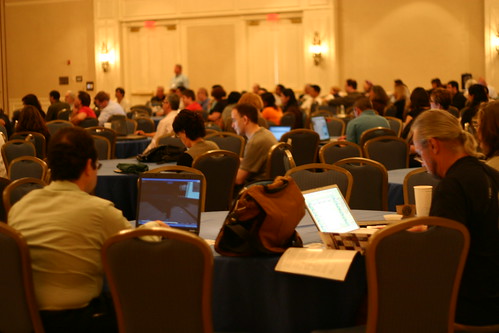The Second Life Education Community Convention (SLEDcc) ran in Tampa, Florida, over the last weekend. Presented here are wrap-ups of three keynote speeches given over the course of the weekend, each with a different focus on the issues facing education in virtual environments.
Why Second Life Can’t Tip: The Power and Perils of Living La Vida Ludic
Presenter: Barry Joseph (GlobalKids Bixby in Second Life)
Barry Joseph is of the opinion that until society becomes more familiar with integrating play into every day life (the “ludic” life), Second Life will not tip.
The word ludic holds its roots in the Latin ludere, meaning “to play”. It therefore shares a common root with the word ludicrous, meaning “amusing or laughable.” Though ludic started out as a word with meanings relating to aimless play and squandering of time, those meanings have lost their derogatory status, so that in the context of modern education the connotations are far different.
According to Joseph, ludic, in this context, best describes the way in which “game/play dynamics, aesthetics and sensibilities … increasingly define our social interactions.” Thus, the ‘ludic life’ is one in which we bring gaming skills to bear in our everyday lives, rather than one in which we treat life as a game, as in the philosophy of ludism.
Until more people are living the ‘ludic life’, it seems unlikely that Second Life will tip. To date, Second Life has hit a major peak in the rate of people joining up, only to have that rate steeply fall off again; clearly the statistics are showing that Second Life is nowhere near tipping yet. Is this what it will take, for us to nurture our game-playing selves, to create ludic lives for ourselves in the real world, in order to make Second Life more appealing?
Explicit Bargains: Setting Realistic (Yet Powerful) Expectations for Teaching in Virtual Worlds
Presenter: Sarah Robbins (Intellagirl Tully in Second Life).
Sarah Robbins’ keynote speech covered how to increase the effectiveness of in-world education. Borrowing from Clay Shirky’s book, Here Comes Everybody, she presented the following structure:
- The promise: what are we expecting to get?
- The tool: how are we going to achieve the promise?
- The bargain: this is what I am going to do; this is what you are going to do. We achieve the promise by fulfilling the bargain.
In essence, “Innovation fails when the bargain breaks down.†However, each part of the structure must be analyzed to ensure that any given educational project goes off well. If the tool is inadequate, the promise is not sufficiently promising, or if the bargain is being consistently broken by one side or the other simply due to circumstance, any one of these can jeopardize the whole project.
Why Johnny Can’t Rez
Presenter: Beyers Sellers (“Metanomics” presenter).
Beyers Sellers addressed the tricky issue of how to get support (funding, resources and other types of assistance) for educational ventures into virtual environments from faculty and other educational staff.
Essentially you need to demonstrate that you are supporting the goals of the educational facility at which you teach by using virtual environments in your classroom. Without this reassurance, you are unlikely to get the support you require.
Sellers identified these three questions as ones that administrators are likely to want answered:
- Which goals, for yourself and for the institution, are being supported, and how will they be supported?
- Why should a virtual environment be used to accomplish these goals, as opposed to another solution?
- What are the costs and risks of using a virtual environment?
In conclusion
Second Life could be a promising educational platform under the right circumstances. However, not only does Linden Lab need to make preparations at their end to make the magic happen, there are plenty of opportunities available for educators, and the wider public, to do their bit to support and improve education on the Second Life grids.

Speak Your Mind